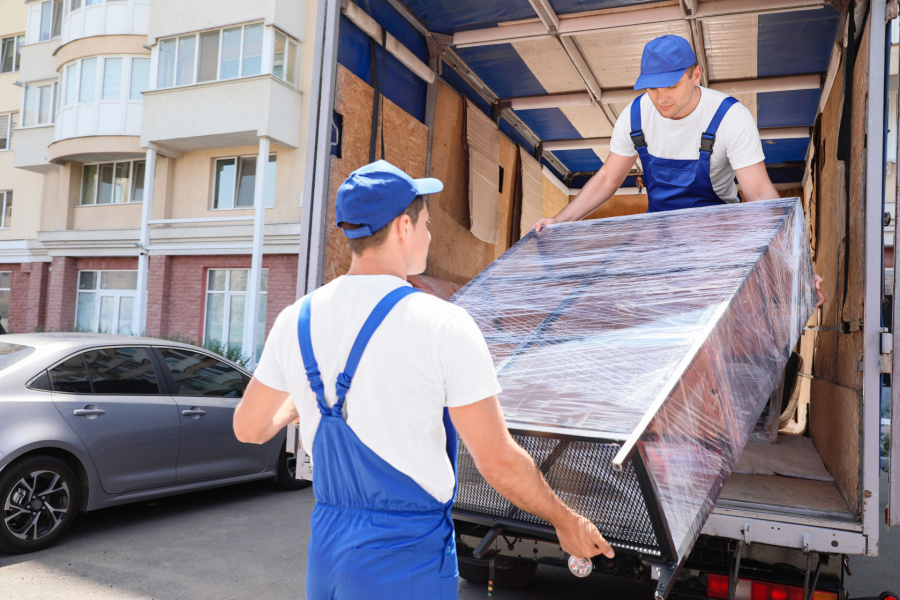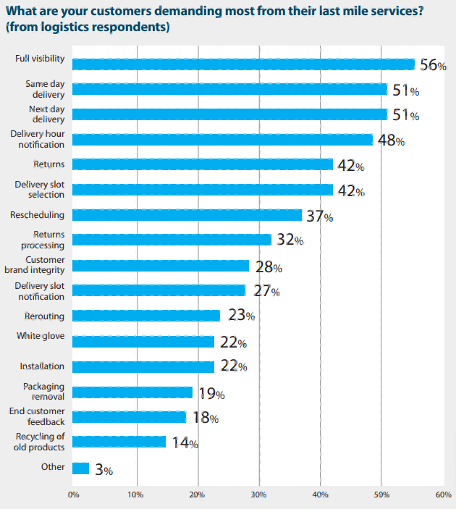Logistics
Warehousing & Fulfillment
Transportation
Industries
Technology & Innovations
E-commerce
E-commerce Fulfillment Services
Lease & Maintenance
Semi Trucks
Logistics
E-commerce
Lease & Maintenance
Buy Used Trucks

Every phase of the supply chain is important, but there’s one stage that receives more attention than any other – last mile delivery.
As order fulfillment grows more streamlined, last mile delivery continues to throw up barriers that prevent customers from experiencing a satisfying delivery process. A slow, expensive, and inefficient last mile is an ongoing challenge for direct to consumer brands – especially as consumer expectations for fast and effective service continue to increase.
With 83% of customers now expecting a guaranteed delivery date and 80% a specified delivery time slot, this leaves very little room for error in your last mile logistics. These rising expectations are causing a boom in the final mile delivery market, with an estimated growth of 15.62% between now and 2027.
In this post, we’re going to explore the challenges with last mile delivery, and what you can do to optimize the last mile delivery experience for your customers.
What is Last Mile Delivery?
Last-mile delivery refers to the final stage of the supply chain where goods are transported from a distribution center or fulfillment center to the end destination, typically a customer's residence or a retail store. This last leg of the delivery process is critical as it directly involves reaching the end consumer.
Put simply, the last mile delivery process is to get orders to the final delivery destination as quickly as possible, damage free, and sometimes with installation. Delivery is one of the most important touchpoints in the customer journey, meaning that the last mile is key to ensuring customer satisfaction and ongoing brand loyalty.
Last mile logistics is considered the most difficult stage of the fulfillment and delivery process because getting the product to the doorstep in a timely, efficient, and most importantly cost-effective manner is a tough prospect for supply chain partners. For retailers who master final mile logistics, the boost customer experience and brand integrity.
How does last mile delivery work?
The process of last mile delivery can vary depending on the nature of the product. Here are some common steps that are involved in the last mile delivery process:
What is the last mile delivery problem?
The ‘last mile delivery problem’ is a common phrase in third-party logistics (3PL) that reflects the immense challenges that logistics partners face during this phase of the shipping process.
Earlier stages of fulfillment, such as order processing, picking, and packing, can reduce costs by handling orders in bulk and creating standardized procedures. The introduction of technological innovations to fulfillment centers, such as software automation and warehouse robot, has helped to streamline these workflows and achieve rapid order fulfillment with lower labor costs.
However, a last mile delivery service cannot rely on these economies of scale. This results in the last mile as the least efficient – and the most expensive – stage of fulfillment.
The final mile of delivery has long been the most expensive part of the fulfillment and shipping process. The last mile can cost as much as 50% of a business’s total supply chain spend!
So, why is last mile delivery so expensive?
Consider that last mile delivery logistics require a business to get a single package to a single address – all within a rapid timeframe. This requires:
When we take these requirements into account, it’s easy to see why the cost of last mile delivery quickly adds up. Unfortunately, these expenses are impossible to avoid if customers are going to receive their orders promptly.
Inefficient delivery patterns
As we’ve already mentioned, last mile deliveries are the point where large-scale fulfillment activities come to an end. Unlike retail distribution services, where a large volume of goods is going to one or two distribution centers, individual orders require a tailored delivery route to reach their final destination.
This means that last mile carriers have to manage complex route planning with multiple delivery points. Depending on whether a delivery route is taking place within a metro or rural area, destinations may be very close together or several miles apart. Together, these conditions make it very difficult for brands and their last mile carrier to streamline delivery logistics.
High carbon emissions
Thanks to frequent stopping, idling, and traffic congestion that reduces fuel efficiency, the last mile of delivery is one of the most carbon-intensive stages of fulfillment. While there is a growing trend of turning to sustainable forms of transportation, such as electric delivery vehicles or smaller trucks, this has a knock-on effect on the cost of the last leg of delivery.
Risk of failed deliveries
A hidden cost of last mile delivery is the difficulties that delivery personnel can face when they deliver packages. Delivery drivers often encounter diverse drop-off locations, from apartments to P.O. boxes or houses with long driveways, which slows down parcel drop-offs and creates more room for error. Nearly 75% of consumers say they’ve encountered delivery failures when shopping online, which seriously impacts the customer experience.
Missed, late, or even lost deliveries are extremely costly to businesses – and not just to their reputation. Rescheduled deliveries, product replacements, and refunds to irate customers quickly add up and can take the margins out of ecommerce sales.
Growing return rates
Returns are notoriously commonplace, with roughly 30% of all online purchases being returned. If a brand is footing the bill for return shipping, this adds significantly to the cost of last mile deliveries. A package has to retrace its journey back to the fulfillment center in a fast enough timeframe to get it ready for resale, which can seriously hurt your bottom line.
Consumer expectations
Thanks to the likes of Amazon Prime making rapid delivery the norm in online shopping, last mile delivery expectations are sky-high. The State of Shipping Report found that 62% of online shoppers expect orders with free shipping to arrive in three business days or less.
In addition to delivery speeds like same day delivery, consumers also expect greater use of technology throughout the last mile fulfillment experience. This includes white glove services like real-time order tracking, scheduling delivery times, return pick-ups, and more:

Source: The Last mile Logistics Whitepaper
To ensure customer satisfaction, businesses are having to pull out the stops and invest in elaborate last mile services that differentiate their brand from the competition. This is causing total shipping costs – and especially last mile delivery costs – to keep climbing.
The impact of poor last mile delivery services
Higher operating costs
If you aren’t managing the last mile delivery process effectively, shipping costs can escalate rapidly. The impact of unoptimized delivery routes, fuel costs, and failed deliveries all add up to create a major hit to your profit margins – to the point where you could start making losses.
Poor customer experiences
The hard truth is that accurate, on-time delivery is no longer a selling point for brands; it’s the bare minimum that customers expect when shopping online. If you can’t deliver (literally) then the chances of a customer shopping with your brand again are slim to none.
If delivery is delayed or missed entirely, customers are going to feel neglected and not valued by that brand. This is why 85% of online shoppers say that a poor delivery experience would prevent them from ordering from that online retailer in the future
How to optimize last mile logistics
For all the reasons listed above, businesses must work with logistics providers who are continuously improving their last mile delivery capabilities. To partner with a 3PL that can offer rapid delivery from fulfillment center to doorstep, here are some key services to look for:
Multiple warehouse locations
Using a centralized fulfillment strategy can cause real headaches where final mile delivery is concerned. The reason is simple; if all customer orders are dispatched from a single facility, this puts you close to some customers – but a long way from others.
Long transit times to your customers mean:
This is a common problem for growing businesses who’ve chosen to fulfill orders close to their initial customer hub. But as order volumes increase nationwide, delivery destinations start to diversify and challenge the efficiency of centralized fulfillment.
By partnering with a 3PL with a nationwide network of facilities in strategic locations, you can allocate customer orders to whichever facility is closest to the end customer. This massively reduces shipping time and costs for faster delivery.
Forward Deployment
Forward deployment in logistics refers to the strategic placement of goods, inventory, or resources closer to the end destination or target market to enhance supply chain efficiency and responsiveness. This approach involves positioning stock or assets at locations that are geographically closer to the point of demand, reducing lead times and improving overall logistics and distribution processes. Forward deployment is particularly relevant in scenarios where rapid and timely delivery is crucial, such a last mile delivery.
Real-time order tracking
Real-time tracking gives your customer greater insight into the last mile delivery process. It also helps to alleviate the anxiety of WISMO (‘where is my order?’) and take pressure off your customer service team.
If an order has gone astray or been redirected to the wrong address, real-time order tracking also helps to identify this quickly – before it impacts the customer experience.
Optimized route planning
Indirect routes are responsible for huge slowdowns during the last mile, as well as increased fuel costs and idling. Optimizing delivery routes for your fleet eliminates travel time and helps customers receive their parcels faster.
Instead of finding whatever is the shortest route between points A and B, optimized route planning uses many criteria. This includes driver schedules, the number of deliveries, and total time available to generate the most efficient delivery schedule. Optimized routes allow you to estimate delivery times with much greater accuracy – meaning better customer service and more positive delivery experiences.
Need help with last mile delivery?
With their superior fulfillment infrastructure and large delivery fleets, partnering with a well-resourced 3PL provider, like Ryder Last Mile, is a cost-effective way to streamline your last mile delivery service. You’ll also gain access to logistics experts who can identify flaws in your last mile delivery strategy that are adding more time onto delivery, which helps to improve customer satisfaction and brand loyalty.